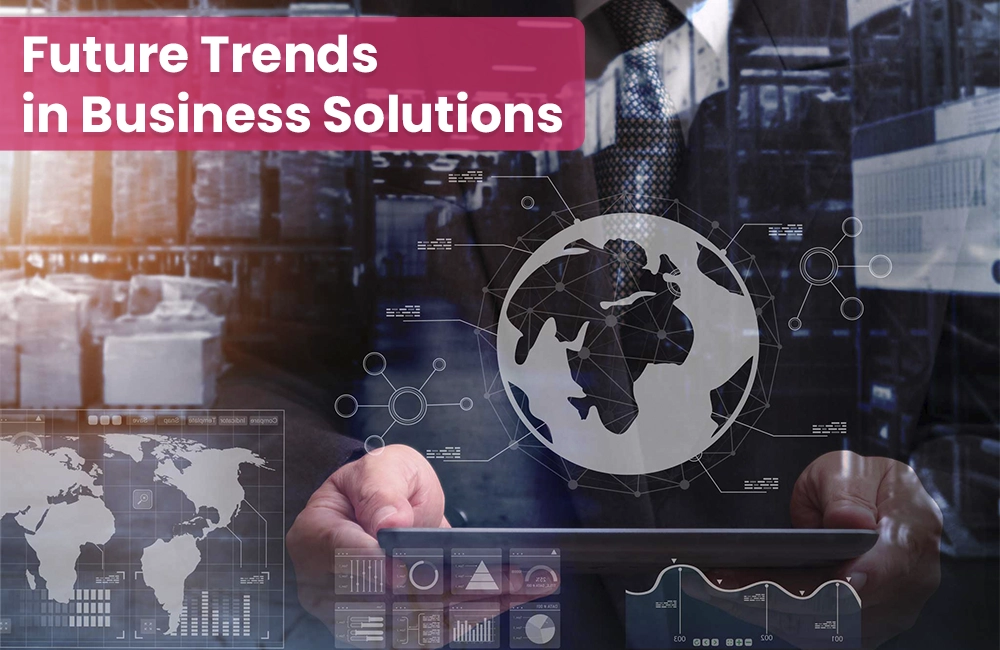In today’s fast-paced and ever-evolving business landscape, digital technologies play a pivotal role in shaping the success and growth of enterprises. Embracing the right digital tools and strategies can significantly enhance productivity, efficiency, and overall business performance. This article delves into the profound impact of digital technologies on modern business solutions and highlights key aspects that drive success in a digitally-driven world.
Digital Transformation: A Paradigm Shift

2.1 The Essence of Digital Transformation
In the modern era, digital transformation has become more than just a buzzword; it is a crucial strategic move that enables businesses to thrive amidst the fast-paced technological advancements. Digital transformation entails adopting digital technologies and integrating them into all aspects of online business operations, fundamentally reshaping the way companies deliver value to their customers and stakeholders.
2.2 Key Drivers of Digital Transformation
Several key drivers push online businesses toward embracing digital transformation. The increasing demand for seamless customer experiences, the need for data-driven decision-making, and the pressure to remain competitive in the market are among the primary forces driving digital transformation initiatives.
Empowering Data-Driven Decisions

3.1 Harnessing the Power of Big Data
In the digital age, data has emerged as a valuable asset for online businesses. Big data analytics empowers companies to analyze vast amounts of structured and unstructured data, extracting valuable insights that drive informed decision-making and strategic planning.
3.1.1 The Three V’s of Big Data
To grasp the essence of big data, one must understand its three defining characteristics: volume, variety, and velocity. The volume signifies the enormous quantity of data being generated, variety highlights the diverse types of data, structured and unstructured, being collected, and velocity underscores the speed at which new data is being created and must be processed.
3.2 Real-time Analytics for Swift Decision-making
Real-time analytics takes data-driven decision-making to the next level. By accessing up-to-the-minute data insights, online businesses can respond promptly to changing market conditions, consumer behavior, and emerging trends, gaining a competitive edge.
Enhancing Customer Experience

4.1 Personalization and Customer-Centric Approach
In the digital realm, customers expect personalized experiences tailored to their specific preferences and needs. By adopting customer-centric approaches and leveraging customer data, businesses can deliver personalized products, services, and interactions.
4.2 Omnichannel Engagement Strategies
The omnipresence of digital technologies has given rise to the omnichannel approach, allowing online businesses to connect with customers across various platforms seamlessly. A well-executed omnichannel strategy enhances customer engagement and fosters loyalty.
Automation and Artificial Intelligence

5.1 Streamlining Business Processes
Automation of repetitive and time-consuming tasks liberates employees from mundane work, enabling them to focus on more strategic activities. This efficiency boost drives productivity and reduces operational costs.
5.2 AI-powered Customer Support
AI-powered chatbots and virtual assistants are transforming customer support operations. These intelligent systems can handle customer inquiries round-the-clock, ensuring prompt responses and enhancing customer satisfaction.
The Impact of the Internet of Things (IoT)

6.1 Revolutionizing Supply Chain Management
IoT devices are revolutionizing supply chain management by providing real-time tracking and monitoring of goods by utilizing digital solutoins. This transparency optimizes supply chain processes, reducing inefficiencies and enhancing reliability. Get more information about IoT by clicking here
6.2 Smart Manufacturing and Industry 4.0
IoT-driven smart manufacturing enables factories to become more efficient and adaptive. Industry 4.0 principles integrate IoT devices with AI and data analytics, leading to predictive maintenance and higher production output.
Cybersecurity: Safeguarding Business Assets

7.1 The Growing Importance of Cybersecurity
Cyberattacks pose a serious threat in a society that is becoming more linked. To protect sensitive corporate data, intellectual property, and consumer information from unscrupulous groups, cybersecurity precautions are crucial.
7.2 Best Practices for Robust Cybersecurity
Adopting encryption methods, conducting regular security audits, and training staff about potential risks are all necessary steps in putting a strong cybersecurity strategy into place and building a safe digital ecosystem.
Cloud Computing: Flexibility and Scalability

8.1 Embracing Cloud Solutions
Online businesses may now access computing resources and data storage at a lower cost due to cloud computing. Businesses can quickly adjust to shifting demands because to the cloud’s flexibility and scalability.
8.2 Cloud Adoption Challenges and Solutions
Although there is no denying the advantages of cloud computing, there may be difficulties in the adoption process, such as those related to data security and integration. To achieve a smooth move to the cloud, businesses must address these worries in advance.
8.3 Stability
While cloud computing offers undeniable benefits, businesses might encounter challenges in its adoption, particularly concerning data security, cyber security and integration. Addressing these concerns proactively is crucial for ensuring the salability of the transition. Recognizing the importance of data protection and seamless integration enhances the salability of cloud migration. Resolving issues related to security and integration beforehand boosts the overall salability of the move to the cloud.
Digital Marketing Strategies for Success

9.1 Content Marketing and SEO
Content marketing and search engine optimization (SEO) go hand in hand to boost online visibility and attract organic traffic. High-quality, relevant content drives engagement and fosters brand loyalty.
9.2 Social Media Marketing
Platforms for social media have become effective instruments for marketing. Businesses may reach a large audience, interact with customers, and create brand communities with the use of efficient social media marketing methods.
Embracing ECommerce and Mobile Commerce

10.1 The Booming ECommerce Industry
The way online businesses offer goods and services has been completely transformed by ecommerce. By embracing ecommerce, online businesses may increase their global reach and access a broader customer base.
10.2 Mobile Commerce: The Future of Shopping
Mobile commerce is taking off as mobile devices and mobile applications become more commonplace. In order to appeal to the expanding mobile-savvy customer sector, websites and shopping experiences must be optimized for mobile users.
Advancing Business Operations with Blockchain

11.1 Transparency and Trust in Transactions
Transparency and confidence in financial transactions are improved by the immutable record that blockchain technology offers. Companies can streamline operations and cut expenses by getting rid of intermediaries. To know more about blockchain technology application click here
11.2 Supply Chain and Logistics Management
End-to-end tracking and visibility in supply chain and logistics operations are made possible by the decentralized nature of blockchain technology. Enhancing traceability and lowering the possibility of fake goods are both benefits of this feature.
Driving Innovation through Open Innovation

12.1 Collaborating with External Innovators
In order to promote creativity and ideation, open innovation entails working with outside partners, such as clients, entrepreneurs, or research organizations. Innovations of digital technologies that change the world frequently result from this collaborative approach.
12.2 Benefits and Challenges of Open Innovation
While there are many advantages to open innovation, companies must also manage obstacles like IP protection and incorporating outside ideas if they are to fully benefit from it.
Sustainable Business Practices in the Digital Age

13.1 Corporate Social Responsibility (CSR)
Businesses in the digital age are expected to embrace sustainable practices in addition to focusing on profits. A dedication to social and environmental causes can be seen in the adoption of corporate social responsibility.
13.2 Environmental Sustainability and Green Initiatives
Taking green actions and lowering one’s carbon footprint not only improves the environment but also builds a company’s reputation and appeals to people who care about the environment.
The Future of Digital Technologies in Business solutions

The future of digital technologies in business seems hopeful as technology continues to advance. New online business prospects will likely be shaped by developments in AI, blockchain, and quantum computing while conventional businesses will certainly be disrupted.
Conclusion
In conclusion, digital technologies have emerged as indispensable tools for modern businesses seeking sustainable growth and success. From digital transformation to the adoption of AI, IoT, and blockchain, leveraging these technologies can revolutionize operations, enhance customer experiences, and drive innovation. Embracing a customer-centric and data-driven approach, along with sustainable business practices, is key to staying competitive in the digital age. Do you want to get more information about digital world and technology? DoFollow us on Facebook, Instagram, Twitter (X), and LinkedIn.
FAQs
How do digital technologies impact customer experience?
Digital technologies enhance customer experience through personalization and omnichannel engagement strategies, fostering strong customer relationships.
What are the key drivers of digital transformation?
The demand for seamless customer experiences, data-driven decision-making, and competitiveness are key drivers of digital transformation.
How does IoT revolutionize supply chain management?
IoT devices enable real-time tracking and monitoring of goods, optimizing supply chain processes and ensuring efficiency.
Why is cybersecurity essential for businesses?
Cybersecurity safeguards sensitive business data and customer information from cyber threats, ensuring business continuity and reputation protection.
What is the role of blockchain in business operations?
Blockchain enhances transparency and trust in transactions, and its decentralized nature optimizes supply chain and logistics management.









Leave a Comment